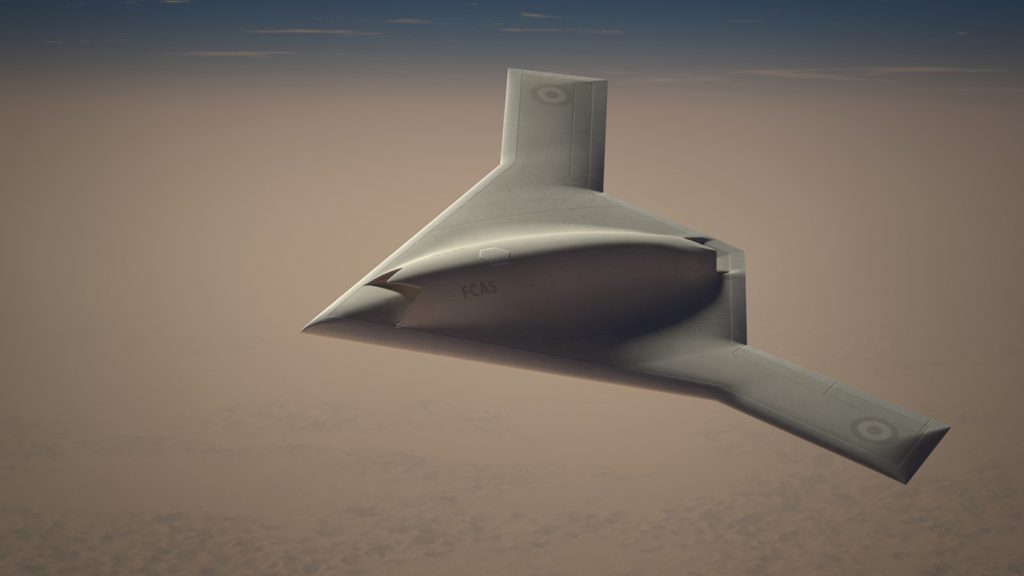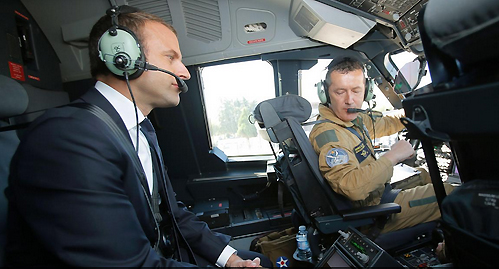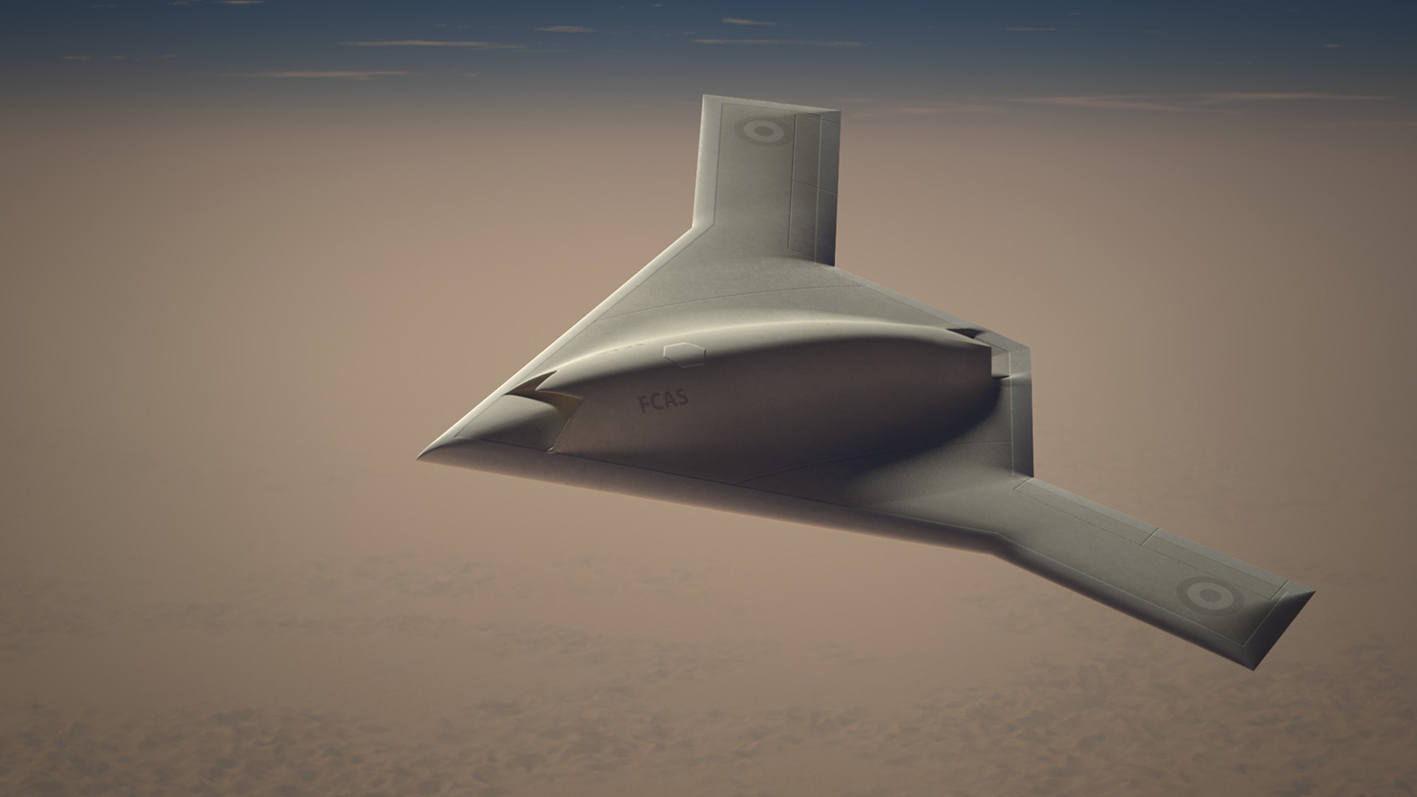
2017 Paris Air Show hit by heat wave
by David Oliver
Fresh from his party’s landslide national assembly victory on Sunday 18 June, a buoyant President Emmanuel Macron flew into Le Bourget for the inauguration on Monday 19 June, despite amazingly high temparatures, on a French Air Force Airbus A400M Atlas and toured the exhibits of French companies including Arianespace, Dassault Aviation, Daher, Safran and Zodiac. The new head of state was accompanied by GIFAS ne president Eric Trappier and Emeric d’Arcimoles, the commissioner-general of the show. Despite unprecendented security, Emmanuel Macron look relaxed and took time to speak with show attendees as he toured, among others, the Futures Pavilion, the USA exhibit and the Kawasaki P-1 Japanese maritime patrol aircraft, one of several debutants at this year’s venue. In a visit that took up much of the day until he left before 4 pm in a French Air Force Super Puma, Macron also had lunch with a group of French SMEs, where he discussed his coming plans for growth, fostering innovation and job creation.
French President E. Macron during his flight to Le Bourget
on a French Air Force A400M. © AFP
This 52nd Paris Le Bourget Air Show was a remarkable success with a record number of exhibitors and 150 billion dollars’ worth of orders announced, despite the slight drop in the number of visitors. A total of 3,450 journalists from all over the world attended the show. Some 140 aircraft were on display, including the Airbus A321neo, Airbus A350-1000, Boeing 787-10, Boeing 737 Max9, Kawasaki P-1 maritime patrol aircraft, Mitsubishi MRJ90, Lockheed Martin F-35 fighter plane, TAI Hürkus trainer, Diamond Dart 450 at Le Bourget for the first time. Dassault Aviation’s Rafale and Falcon 8X, the Airbus A380 and A400M, the Airbus Tiger and NH90 Caiman helicopters were popular with the public.
Present during the show were 290 official delegations from 98 countries and 7 international organizations, including 160 official defence delegations from 86 countries and 4 organisations (NATO, the UN, OCCAR, the EU), including 16 foreign ministers, 40 chiefs of staff, 20 deputy-ministers, 110 civilian and institutional bodies with 15 ministers and 40 directorate from General Aviation Authorities or their equivalents. And 20 other varied delegations.
Le Bourget 2017 was held during one of the hottest weeks of the year in Paris, but hot news from the military sector of the aerospace industry was hard to come by at an air show dominated by the commercial aviation giants Airbus and Boeing with Embraer and Bombardier snapping at their heals.
Airbus Defence and Space:
by David Oliver
While the flagship of Airbus Defence and Space, the A400M still suffers from problems and delays that have prevented any new sales this year, its smaller stablemate, the C295 medium transport was breaking new ground with the announcement at Le Bourget that Canadian Aviation financier and lessor Stellwagen signed an order for 12 Airbus C295, the first to a leasing company.
The contract, which includes options for a further 12 aircraft, positions Stellwagen to address civil markets including the humanitarian sector, freight operators in austere environments, and government agencies such as search and rescue services.
It was also announced that Airbus Defense and Space is set to deliver its first armed intelligence, surveillance, and reconnaissance (ISR) C295 aircraft to an undisclosed customer in September. The modified aircraft features a nose-mounted forward-looking infrared (FLIR), a multimode search radar with maritime and ground surveillance modes, and a palletised version of Airbus’ newest Fully Integrated Tactical System (FITS), with additional screens for improved situational awareness. The C295 will be armed with two 12.7 mm manually operated heavy machine guns (HMG) firing through the rear parachuting doors.
The company also claimed that African air forces are showing growing interest in the C295, with Burkina Faso, Côte d’Ivoire, and Senegal considering the aircraft to meet outstanding air transport requirements. It is already in service with the Ghana Air Force.
The Nigerian Air Force is also looking at the aircraft to supplement its Lockheed Martin C-130 fleet and fill the gap left by the withdrawal of its Alenia G222. Contract negotiations remain ongoing with Equatorial Guinea regarding the sale of a single transport configured C295 plus a maritime surveillance version.
The C295 is a nine-tonne capacity, ramp-equipped, medium transport and mission aircraft in-service with 28 operators in 25 countries. The agreement with Stellwagen took firm orders for the type to 198 and the options would take the figure past 200.
ONERA
by David Oliver
ONERA is the French aeronautics, space and defense research laboratory, and a multi-disciplinary organization with experimental means unique in Europe. ONERA brings expertise to government programmes, both institutional and industrial. Research at ONERA meets the major challenges of the aerospace and defense industries and is the only organisation in France gathering all the knowledge and skills in these areas.
The Racer high-speed rotorcraft demonstrator revealed by Airbus Helicopters at Le Bourget contains ONERA’s DNA. Since July 2015, ONERA has been a partner of Airbus Helicopters in improving the aerodynamic performance and noise reduction of the successor demonstrator of its X3 twin-engine high-speed compound helicopter demonstrator. ONERA’s contributions are to be found in the Racer’s propellers, or lateral rotors, for which ONERA participated in their design and optimization for the various flight phases of the rotorcraft, enabling a significant gain in consumption, both in hover and cruise flight conditions, while ensuring significant noise reduction (of the order of 3 dBA) compared to the design of the preliminary design phase.
ONERA also contributed to the design choices and aerodynamic optimisation of the rear parts and in particular the vertical-tail planes and their “X” shape. Finally, ONERA has carried out acoustic analyses of the demonstrator in a wide range of flight conditions that will be used to identify the least noisy procedures.
Architecture and performance analyses concerning the Anglo/French Future Combat Air System (FCAS) is also being carried out by ONERA together with France’s Direction générale de l’armement (DGA). The aim is to estimate, using the technical operational simulator BLADE, a software platform conceived through an internal project financed by ONERA, the strengths and weaknesses of a drone and its concept of use as a complement for other platforms including armed manned aircraft, cruise missile, etc. for carrying out various missions in a non-permissive environment.
ONERA is conducting architecture and performance analyses of
the Anglo/French Future Combat Air System (FCAS) for DGA. (Dassault)
BLADE is ONERA’s simulation laboratory. It is a generic IT infrastructure that allows the study of emerging issues by simply assembling or adding models of aircraft, drones, satellites, weapon systems, C2 centres, environment, sensors, etc. Its interactivity and its ability to graphically define complex scenarios make it possible to simulate systems of systems with maximum efficiency.
Also showcased at Le Bourget was the ONER Avion à Motorisation réPartie Électrique de Recherche Expérimentale (AMPERE), a distributed electric propulsion regional aircraft demonstrator for transporting between four and six people over 500 km in two hours. Xavier Lansel, ONERA’s Aeronautics Key Account Manager told EDR that one of the challenges is to achieve optimal propulsion performance while generating as little drag as possible. Distributed electric propulsion leads to rethinking aircraft design in order to obtain both aerodynamic and flight control benefits. The primary objective of the AMPERE project is to bring the distributed electric propulsion technology to maturity. ONERA seeks to explore innovative solutions in order to provide validated and integratable technologies to industry.
Lansel explained that the advantages of distributed electric propulsion include the reduction of energy losses due to friction, due to boundary layer ingestion by means of the 32 fans located on the wing upper surface. This enables taking off and landing over short distances, using engines with a wing blowing effect, which increases lift at low speeds, while engine participation in the steering of the aircraft with a differential thrust resulting in a movement or stabilisation of the aircraft. There is no discharge of pollutants during the operating phase and there is improved flight safety by pooling functions using engines with a wing blowing effect. Aerodynamic performance prediction calculations on a 1/5th scale wind tunnel model powered by 32 fans have been validated in the ONERA L2 wind tunnel in Lille.
CNIM
by David Oliver
The CNIM Group and its subsidiary Bertin designs, develops and manufactures industrial solutions with high technological content and provides expertise, services and operating capability in the areas of defence and high technology.
Following the signature of the partnership agreement with Thales Alenia Space in April 2016, an initial design milestone was passed in March 2017 and things are looking very encouraging for the next stages of this unprecedented project, involving a solar-powered geostationary and stratospheric aerostat. CNIM is responsible for the most important mechanical components of the Stratobus structure, its two nacelles and the four structures that support its propulsion engines.
The CNIM Group and its subsidiary Bertin is one of the six industrial partners assembled by Thales Alenia Space to work on the Stratobus multi-mission autonomous drone project. Stationed at an altitude of 20,000 m above the Jetstream and air traffic, over its theatre of operations, in the lower reaches of the stratosphere, Stratobus will be positioned between aircraft and satellites.
The CNIM Group is partnered with Thales Alenia Space to on the
Stratobus multi-mission autonomous drone project. (Thales)
The aerostat is designed for localised civil or military observation and surveillance missions, e.g. surveillance, detection of pirate ships, oil dumping and spills at sea, etc. It will bring the Internet to digital deserts, reinforce GPS in high traffic areas, analyse meteorological and coastal erosion data, and monitor beach cleanliness. It will help the authorities to manage natural disasters and fires. In addition to the more global coverage provided by satellites, its detailed regional coverage will help to monitor threats of all kinds.
The engine support structures, energy management component and communications and surveillance payload nacelles will be produced using an ultra-light, very high-quality composite material border. The seven metric tonne 110 m-long Stratobus will have to constantly battle against winds blowing at speeds of between 0 and 90 km/h, in order to maintain itself in a stationary position: this poses a serious technological challenge for CNIM, which is responsible for the design and production of the 3 structural units.
The Preliminary Design Review (PDR)] will take place in mid-2017 followed in 2018 by the Critical Design Review (CDR), which will provide a detailed definition so that actual production can be launched.
Lacroix
by David Oliver
Lacroix provides the Armed Forces in France and abroad with a complete range of self-protection pyrotechnic systems and training devices for airborne, land and naval applications and showcased its latest air defence products at Le Bourget. Its range of infrared (IR) decoy flares, including Magnesium/Teflon/Viton (MTV), spectral and kinematic, and 1”x1” chaff dispensers are produced in compliance with STANAG 4687 to protect helicopters such as the NH90, Caracal, Tiger, etc., and transport aircraft, the C-130, A330, KC-390, etc.
Lacroix airborne countermeasures have been used on Rafale combat aircraft
in Afghanistan, Mali, Libya and Iraq. (David Oliver)
Lacroix’s NATO 2”x1” MTV decoy flares designed for fighter aircraft including the F-16 and transport aircraft, including the spectral series LIR 120/121specific to the A400M, are combat proven and employed by numerous countries. Calibres specific to fighter aircraft are provided in 40mm and 60mm diameter – MTV and spectral from the Mirage 2000 to the Rafale while the 50 mm LIR 500 cartridge is designed for platforms equipped with Russian format dispensers such as the Sukhoi 30.
DCI
by David Oliver
Défense Conseil International (DCI), the reference operator for the transfer of the French armed forces’ know-how, has invested in a Diamond DA42 Multi-Purpose Platform (MPP) aircraft to expand its offer in airborne intelligence, surveillance and reconnaissance (ISR). The twin-engine all-composite aircraft on static display at Le Bourget also has an aeronautical training role used for close air support (CAS) training of foreign trainees. It will be used for aeronautical maintenance training of student maintenance technicians.
Four trainees from a partner country of France recently came to Nancy Ochey Air Base to learn the fundamental notions of CAS in a geographical environment that is more complex than their home country. Supported by three instructors, all ex-military experts in this sector, the trainees acquired initial close air support capacities in accordance with French Air Force standards at the Franco-German close air support training centre, whose competencies are combat proven.
The DCI Diamond DA42 MPP Guardian ISR aircraft used for
close air support (CAS) training of foreign trainees. (DCI)
The DA42 is the most appropriate training solution for this purpose: as well as being more economical than a fighter aircraft, it is rugged and enables trainees to rapidly acquire the fundamental notions of CAS, including knowledge of phraseology and basic close air support procedures.
In another sector of aeronautical expertise, the French Defence Aeronautical Institute (FDAI), a training structure jointly created by DCI and Dassault Aviation, is offering ab initio theoretical and practical training in all the specialities of aeronautical maintenance featuring cutting-edge innovations and technological excellence. Around 150 trainees are attending the FDAI in 2017. Instructors have designed and implemented a technical training course that introduces the young trainees to the reality of work on the flight line. To complement the theoretical training and offer added value for trainees essentially centred on training related to flight safety reflexes relative to an aircraft on the flight line, the use of the DCI DA42 in real conditions allows realistic practical work to be performed. Training includes all aspects relating to the aircraft environment on the flight line.
Diamond Aircraft
by David Oliver
The Austrian manufacturers of the DA42 MPP, Diamond Aircraft displayed three all-composite aircraft for the first time at Le Bourget. These included the TerraStar, a multi-sensored DA42 variant optimised for the detection of unexploded ordnance (UXB). It is capable of flying at low altitudes, between 50-150 m at only 156 km/hr where the aircraft’s low noise and vibration levels, an innate stability reduces pilot and observer fatigue.
Flying at 100 m the track width covered by the sensors is equal to the DA42’s wingspan of 13.5 m. Trails of the TerraStar system were carried over disused live firing ranges in Austria to detect used shell in mid-2016 and two aircraft have been sold to a West African customer.
Making its public debut at Le Bourget was the DA62 MPP, a seven-seat development of the DA42. Powered by twin 134 kW Austro Engines AE300 diesel powerplants it is being offered in the ISR or maritime patrol aircraft (MPA) configuration. The engines are fitted with an on-top exhaust system to reduce noise and the heat signature making the aircraft virtually invisible to surface-to-air missiles (SAM) while the composite airframe reduces the radar cross section (RCS).
Making its public debut at Le Bourget, the Diamond DA62 MPP
is offered as a multi-sensor ISR of MPA platform. (David Oliver)
With a maximum speed of 352 km/h and service ceiling of 20,000 ft, it has exceptional range and endurance capable of flying up to 10-hour non-stop missions. It has a payload of up to 710 kg for the crew, mission equipment and fuel while the field-proven composite technology allows corrosion-free unlimited airframe lifetime.
The ISR variant of the DA62 MPP is equipped with the lightweight FLIR Star SAFIR 380 HD camera, a digital line of sight (LOS) bi-directional datalink and beyond line-of-sight (BLOS) Ku-band Satcom. It is fitted with the compact Garmin GWX 70 weather and the observer station is equipped with a Diamond in-house designed ABACUS 2.0 mission computer with a 17-inch full HD screen.
The proposed MPA variant is offered with the Thales new I-MASTER lightweight high performance combined Synthetic Aperture Radar (SAR) and Ground Moving Target Indicator (GMTI), the US ViaSat and the AIS global ship tracking system.
Diamond Aircraft’s other Le Bourget debutant was the Diamond Aircraft Reconnaissance Trainer (DART)-450, the first all-composite tandem, two-seat basic trainer with a sidestick and pneumatic ejection seats that made its first flight on 17 May 2016. The +7/-4G aerobatic aircraft is powered by 331 kW Ivchenko-Progress/Motor Sich AI-450S turboprop engine driving a five-blade MT-Propeller, and equipped with a GARMIN avionic system. The maximum endurance of the DART-450 is eight hours plus reserve. It will have a maximum speed of 250 knots.
Two prototypes have already flown and a third production standard DART-450 is in production. The aircraft will be offered with either the AI-450S or GE 500 engines, with optional Martin-Baker or Russian ejection seats. With a lead customer already signed, the first production DART-450 will be delivered in 2018.






